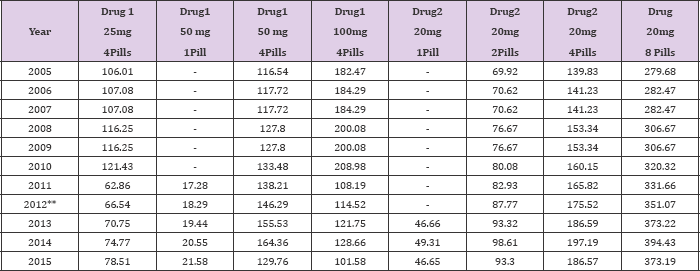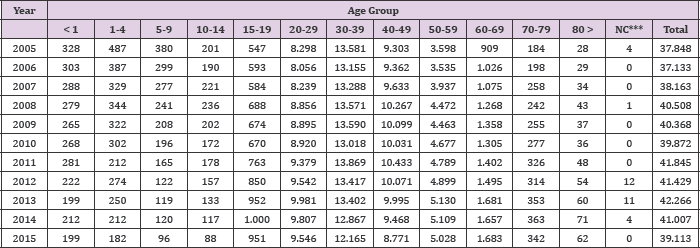Impact Factor : 0.548
- NLM ID: 101723284
- OCoLC: 999826537
- LCCN: 2017202541
Dennis Minoru Fujita*, Luiz Henrique da Silva Nali, Paulo Roberto Palma Urbano and Expedito José de Albuquerque Luna
Received: Junuary 29, 2018; Published: February 21, 2018;
*Corresponding author: Dennis Minoru Fujita, Av Dr Enéas Carvalho de Aguiar, 470 - 2° andar, Sao Paulo - Brazil
DOI: 10.26717/BJSTR.2018.02.000782
The economic development in emerging countries promoted an increase of access for new medical technologies and services which improve the life expectancy of your population at last 10 years [1]. In Brazil, the increase of senior group is accompanied by new demands for a better quality of life, based on the interaction and social integration of the elderly [2]. However, this social renaissance may be followed by agents that did not represent a risk for this group [3]. Either by lack of preventive knowledge or by the cultural conduct to not use condoms, in the past, of this generation. Our study assessed the number of HIV-infected from Brazilian Ministry of Health public database (DATASUS) during the last 10 years. We focused on analyzing the frequency in senior age group, which was divided in the following distribution by age: 60-64, 65-69, 70-74, 75-79 and 80<years old. We compared the price's evolution from the two main drugs for erectile dysfunction (Drug 1 and Drug 2) at Agencia Nacional de VigilanciaSanitaria - ANVISA database in the last 10 years. Today, there are ~36.7 million people infected by HIV in the world, whereas in Brazil there was an increase in estimated number of people (all ages) living with HIV(n~700.000 in 2010/ n~830.000 in 2015) in Brazil, with an estimative of ~15.000 deaths/year [4].
In Brazil, the group from 60 to 64 years old (Table 1A) initially presented a considerable number of HIV reported cases (n=5069 - 2005) by different transmission routes of infection including sex and still concern after 10 years in this specific age group (n= 7797 - 2015) with an increase of 53.82%. The last age group (80 < years) presents a considerable estimated prevalence of HIV (n=2.112 in 2005/n=3.308 in 2015) presenting an increase of 56.63%. This result might be explained by multiple reasons as follows: The drugs for erectile dysfunction presented more options of dosage with the reduction of the active ingredient (Drug 1 - 25 mg, 50 mg and 100 mg / Drug 2 - 20 mg) and consequent price reduction, (Drug 1 - R$24.210 - 25mg - 1pill / Drug 2- R$52.49- 20 mg -1pill) which provide more presence and availability to a larger group of consumers in Brazil according to ANVISA's database in 2016 (Table 1B). The increase in Brazilian life expectancy present a continuous growth that was 9.8% in 2005 and in 2015, the last available data, was 14.3% shows us new problems related to the resocialization in old age, which includes the right to leisure, group activities and even sexual activity.
Considering the diversity of drugs for erectile dysfunction available in the market and their relative decrease in price over the last 10 years in Brazil, allied to the growing participation of old group in dating apps (56 to 64 year olds - doubled the use of online dating services from 2013 to 2015) (Table 1C) [5]. The estimative of individuals living with HIV in all old age group in Brazil (60 to 80 years old - n=23.940in 2015), and the constant increase of reports at last 10 years (>86.17%), may be consider as a consequence from a unexpected problem (Figure 1). Probably, the monogamous behavior induced by social and religious precepts protected this population at past, but in the search for a new companion, they may develop unprotect sex because contraception was the big problem at their young age, and disregard the dangers of sexually transmitted diseases, since they were a problem related only to people with "questionable character", as drug addicts [6]. Emerging countries have similar growth of their elderly population and may present the same problems with considerable development of sexually transmitted diseases in the senior age. We may consider urgent a sexual education program for this special age group, and maybe a more specific palliative method in the sale of these drugs to this group, due to this continuous increase in HIV prevalence in old age.
Table 1A: Estimated Prevalence of HIV in Elder People-Brazil.

Table 1B: Price Evolution (BRL Currency*) - Erectile Dysfunction Drugs.

Figure 1: If the overall slopes were identical, there is less than a 0.01% chance of randomly choosing data points with slopes this different. We can conclude that the differences between the slopes are extremely significant. Because the slopes differ so much, it is not possible to test whether the intercepts differ significantly.

Table 1C: HIV Positive Cases Reported/Age - Brazil - 2005/2016.

The authors wish to acknowledge the assistance from Institute de Medicina Tropical de Sao Paulo - USP, LIM - 49 / LIM - 52 - HCFMUSP, FAPESP and CAPES.


